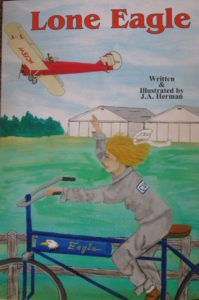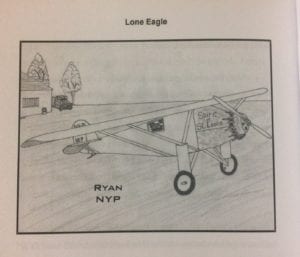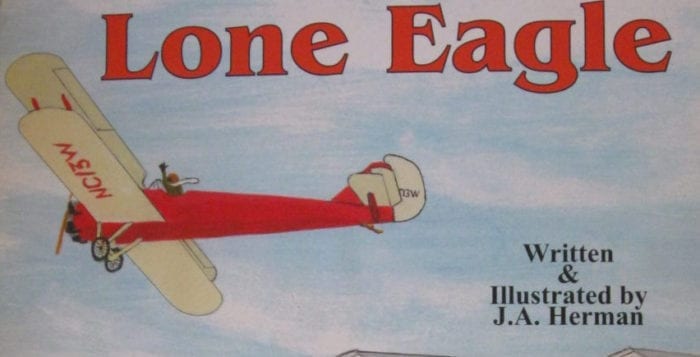By Rita J. Egan

Long Island has long been home to many important events in the field of aerospace, particularly during World War II, leading to its iconic nickname as the “cradle of aviation.”
In an effort to help keep the island’s aviation history alive for the next generation, Port Jefferson Station resident John Herman has written a historical fiction book, “Lone Eagle.”
Children will be delighted to join 12-year-old Clementine, the protagonist of “Lone Eagle,” on her adventures during the golden age of aviation. An added bonus for those who live on Long Island is the main character’s hometown of Garden City, a short distance from Curtiss and Roosevelt fields, in a time before the latter became a shopping mall.
While Herman grew up in a different era, just like Clementine, he lived in Garden City as a child and was in close proximity of Mitchel Air Force Base and fascinated with aviation.
The book, which is Herman’s first published work, takes place in 1927 and follows Clementine during her visits to local airfields at a point in time when flying an airplane across the Atlantic Ocean nonstop was just a dream.
The tomboy, whose nickname is Lone Eagle, is determined to be a part of the race to fly across the ocean in her own way by trying to give each pilot a good luck charm, and her quest takes her on an adventure where she meets many interesting characters. The book is historically accurate, which is demonstrated many times, not only with the author’s documentation of historical events such as Charles Lindbergh’s awe-inspiring solo nonstop transatlantic flight in the Spirit of St. Louis from Roosevelt Field to Paris in 1927, but also as Clementine and others keep up with the latest news by reading newspapers, listening to the radio in the parlor and making calls from telephones located in hallways.

Throughout the book, Herman’s pencil drawings depicting airfields, airplanes, as well as other scenes, are a charming addition. At the end of the story, the author lists the Atlantic flight time line to enhance readers learning experience.
In the introduction, Bob Mott, museum director of the Bayport Aerodrome Society, writes “many young people on Long Island today grow up with little knowledge of the aviation history that took place here back during what has become known as the golden age of flight . . . [This is] a must read for any young person who is interested in aviation.”
Recently the author took time out to answer a few questions about his latest venture.
How did you become interested in aviation?
As a youngster, I built models of airplanes and read aviation history. In high school, I built radio-controlled models and then started flight training at Zahn’s Airport [in North Amityville].
What is your day job?
I work for Creative Models and Prototypes, in Hicksville. They are a spin off of the old Grumman model shop. We make prototypes of inventions and models of all types (test, display, volumetric, etc.).
Did you always want to be an author and illustrator of children’s books?
I can’t say I started out wanting to be an author, but when I began reading children’s books to my own children, it began to take on an appeal. I have always been an avid reader. When you combine that with an interest in drawing, eventually an illustrated manuscript was bound to happen.

What was your favorite book as a child?
As a kid I read the Tom Swift series among others. The Redwall series was a favorite to read with my son, and of course, both of my children enjoyed being read Harry Potter.
Did you base the character Clementine on a child in your life?
Clementine is not based on anyone in particular, although I probably would have been right beside her if I had been 12 years old in 1927. I know we would have shared an interest in all things aviation.
Are there any experiences that Clementine went through in the book that you identify with from your own childhood?
Like Clementine I was always fascinated with aviation. I spent hours exploring the abandoned Mitchel Field Air Force Base. If Roosevelt Field had still been an airfield rather than a shopping mall, I’m sure I would have spent a lot more time there.
How would you sum up the book for someone who hasn’t read it?
“Lone Eagle” is a close-up look from a child’s perspective of what was — at that time — the world’s most challenging technological achievement. Clementine wants to be involved, and in her own unique way, she is.
For what age group is this book best suited?
“Lone Eagle” is a beginning chapter book for readers from 8 to 11.
What is your process when creating a book?
This is a tough one. I usually get the inspiration to write from a specific event or occurrence that triggers an idea for a story. Once the story starts to take shape, it gives me a feeling for the style of illustration that I think will work best.
What advice would you give someone who is interested in writing a children’s book?
I think that, at least for me, the easiest and best subjects for creating a children’s book come from personal experiences, things that I am familiar and comfortable with.
Any upcoming book signings?
I don’t have any signings scheduled right now, but “Lone Eagle” is available through Amazon.
For more information about the book and the author, visit the Lone Eagle Facebook page.





